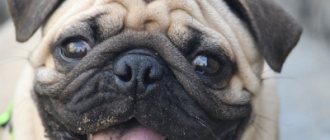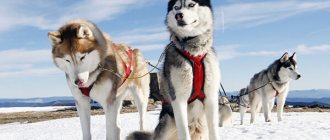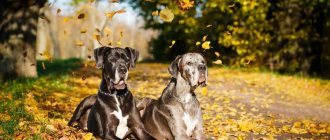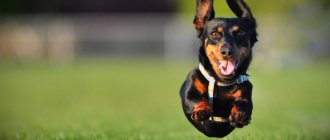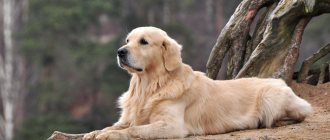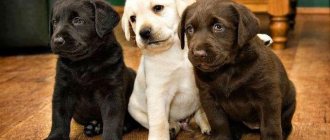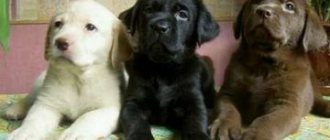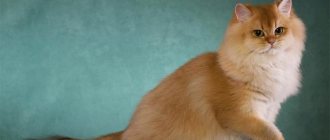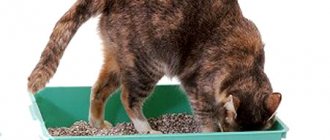The Rottweiler is an intelligent, loyal, non-aggressive dog. She learns quickly, so she is used in the service of law enforcement agencies.
Breeders tried to get new animals by mating the Rottweiler with other dog breeds. This article will tell you in detail what types of mestizos exist and why they are unique.
Breed and crossbreed
It all started with the domestication (domestication) of wild dogs by man. Subsequently, people were able to realize organized groups of animals with similar parameters of appearance and behavior, passed on from generation to generation. A modern purebred animal is the product of a complex long-term activity (zootechnical selection), the final product of which is a livestock that is homogeneous in appearance and behavior.
Pedigree is approved and subsequently declared by international cynological federations. Today, the authoritative FCI identifies 15 genera and 45 species of the canine family (more than 400 unique names).
As soon as humanity “accumulated” a fair collection of purebred types, half-breeds appeared, crosses between representatives of different species. Outbreeding was practiced when it was necessary to strengthen certain personal characteristics, change the appearance, and improve health. Pedigree animals of elite blood are used in inbreeding:
- to increase the viability of the offspring, activate the effect of heterosis (“hybrid vigor”);
- to obtain a dog that combines the best features of the parent breeds;
- to exclude unwanted recessive traits leading to genetic pathologies;
- as a basis for developing a new breed.
At the end of the twentieth century, the craze for “generic cocktails” was called “designer selection”: large scientific centers, commercial nurseries, and eminent animal geneticists took up the delights and artifacts of canine design.
Training allows testable combat
To consolidate various service qualities for working dogs, special test fights were invented. Also, combat tests allow you to find out which of the participants put up for battle is stronger, more savvy, more agile, and braver. During a fight, you can notice the advantages and disadvantages of a dog, which you may not know about in everyday life.
Test fights are events supervised by experienced keyologists, but in no case are officially prohibited bloody dog fights.
For each test fight there are strict sporting rules, violation of which leads to fines or disqualification of participants. Those who violate Article 245 of the Criminal Code of the Russian Federation (cruelty to animals) can expect fines, compulsory or correctional labor, or restriction of freedom for up to one year, or arrest for up to six months.
Controversial chronology
Most information sources talk about the birth of the “designer pet movement” in Australia, citing a successful project of cross-breeding a Labrador retriever with a poodle. This is not entirely true: crossing different breeds is a long-standing zootechnical practice. Most “young” dogs are the result of mixing blood, collecting talents, and chasing the desired phenotype.
For example, the best breed created in the Soviet Union, the black Russian terrier, was developed through planned outbreeding. In 1949, an excellent set of elite pairs of Giant Schnauzers, Newfoundlands, Rottweilers and Airedale Terriers of good blood arrived from Germany to the Moscow Zootechnical Institute in 1949. Soviet canine scientists, under the leadership of biologist professor Ilyin and Major General Medvedev, carried out a government order: the selection of a new service and guard dog for work in harsh climatic conditions. The result of the most complex and very long work: the “black pearl of the USSR”, a magnificent “designer hybrid”, frost-resistant, powerful and hardy, ferocious and vicious (with excellent control and manageability) “Russian blackie”.
Summing up
A mixed breed of Labrador Retriever and German Rottweiler is a very young project of the fashion trend of “designer selection”. It is difficult to predict the pros and cons of such a hybrid: it is difficult to determine the dominant gene during crossing. As geneticists joke: absolutely anything is possible - loving, cute Rottweilers and shy Labrador retrievers.
- Labrador
- Retriever
If you find an error, please select a piece of text and press Ctrl + Enter.
Labrador/Rottweiler mix
Several attempts have been made around the world to use the excellent condition of Rottweilers.
The most successful breeding project is considered to be a mixture of a Rottweiler and a German Shepherd: Malchover dogs are actively cultivated in Germany. The mixed breed of Rottweiler and Labrador is not so popular: there are very few mentions of systematic work on this “designer craft”.
Let's consider the genetic “sources”, analyze the available information, and try to predict the “half-breed” future.
Labrador retriever
Labras are a very popular breed of retriever, a gun dog native to the island of Newfoundland. English selection carefully worked with the Canadian canine “archetype”: St. John's dogs went through a long series of improving interbreed matings. As a result of breeding work, the world received a powerful, stocky dog with a hard coat that protects the animal well from unfriendly climatic conditions.
Labradors are large, but not heavy dogs: males weighing from 30 to 36 kg reach a height of 56-57 cm at the withers. They are charming, smart and hardworking. The main advantages of the retriever species are their friendly disposition and bright (active) temperament. As is very often the case in dog breeding: positive closely borders on negative, hyperactivity and over-friendliness of labs complicate upbringing, socialization, training and life support.
Rottweiler
Rottweilers are working dogs of the Molosser group, bred in the mid-eighteenth century in the province of Rottweil, Baden-Württemberg in southwestern Germany. Farm dogs for driving livestock, transporting goods (animals were harnessed to carts) and protecting life and property were often called German butcher dogs.
Massive dogs of a balanced constitution do not look overloaded or raw: the entire appearance of the Rottweiler declares rapid power, agility and endurance. The height of males at the withers is 62-68 cm, females are smaller and more graceful: 55-63 cm. The weight of adult individuals varies in the range of 40-50 kg.
The coat consists of a coarse, tight-fitting awn and thick undercoat. The breed standard dictates only one color: black anthracite with a pronounced tan of a red-brown tone.
Rottweilers are serious, courageous and confident animals. This is a canonical release of classical German selection: the breed requires strict dominance of the owner, a clear vertical of power and professional training. Without thoughtful and systematic socialization and training, Rottweilers “fly off the rails”, display aggressive viciousness and combative impudence.
German Rottweilers are ideal service dogs, “toothed gendarmes”, hard workers, created for complex and responsible work: guarding property and protecting the life of the owner.
Brief characteristics of the Rottweiler
A reliable and courageous Rottweiler is able to protect the owner, his family and property, and repel attacks from intruders. Dogs of this breed harmoniously combine strength of character, independence, poise, devotion, endurance and fearlessness.
In battles with the enemy, Rottweilers have repeatedly proven their superiority, but only when it was necessary . But is this dog as strong as they say? Let's look at a few examples.
Labradorotweil - a mix of Labrador and Rottweiler
mixed-breed puppy , obtained from the mating of Labrador and Rottweiler , is a complex canine artifact, the heir to good parameters of intelligence, conformation and temperament. The essence of the problem: distribution of inheritance. All the talk in the “design community” about genetic recessivity and the plasticity of German breeding releases does not stand up to criticism: German blood is strong and extremely dominant.
The baby Labrotweil is certainly powerful, stocky and charming (the constitution and type of Rottweilers and Labros are very similar), but the balance of temperament parameters and temperament in this situation turns into a real “Russian roulette”. No matter how strong the Labrador blood is, it cannot “break” the German drive and combativeness. And let's not forget that Rottweilers are among the twenty most vicious fighting breeds.
Experts in selective canine design say: mating in the first generation is of little effectiveness and means nothing. A real designer pet release is obtained after many years of work. To consolidate a type, obtain a guaranteed transfer of qualities from generation to generation, and create a truly new breed, years of painstaking work are needed. Only ruthless culling of litters, systematic monitoring of the condition of mestizos, consolidation of the archetype with improving blood - make the designer craft a curiosity - a real new breed.
Work on the Labrotweil ( a hybrid of the Rottweiler and Labrador breeds ) is at the very beginning of its journey; we need to wait for several generations of dogs, and the horizons of the breed will become clearer.
Comparison with other dogs by qualities
German Shepherd
Shepherds and Rottweilers are loyal, strong, hardy creatures. They cope well with assigned tasks, protect and guard their territory. But the German is calmer and friendlier, which cannot be said about the Rottweiler.
Cane Corso
Here the Rottweiler serves as a guard, and the Cane Corso acts as a bodyguard. The second breed has its disadvantages: it sheds for a long time and secretes excessive saliva.
Both breeds have similar personalities. But the Cane Corso requires an active lifestyle, so it is important to provide him with regular exercise.
Pitbull
The differences lie in behavior and tendency to train:
- The pit bull is a vigilant protector, guardian, and an excellent companion. He easily adapts to a new family and tries in every possible way to please his owner. Protects other pets. For example, a dog will distract a person while the cat steals treats from the table.
- The Rottweiler demands to be treated as a full member of the family. However, he will only be affectionate with a kind and intelligent owner. This breed should not be underestimated. The Rottweiler can easily trick a person into not following any commands.
Staff
The Staffordshire Terrier has a softer and more flexible character, which cannot be noted in the Rottweiler. Both breeds are easy to train, get along well with people, are strong and resilient. They equally love to be lazy: they prefer to sleep or relax most of the time.
Ca de bou
The Spanish Mastiff differs from the Rottweiler in the following features:
- Despite its formidable appearance, the dog is unusually sensitive and kind. Patient with children, cats and other dogs.
- Calmly assesses the situation, reacts quickly in emergency situations, and thinks logically.
- The dog is active and loves sports. Therefore, it is not recommended to keep him in his apartment. Otherwise, it will damage the furniture and equipment.
Attention! Both breeds require quality training under the guidance of an experienced trainer. If you don't take care of dogs, your four-legged friends will grow into dangerous fighters.
Labrador
The Labrador is not considered a fighting breed. He is very kind and affectionate. The dog can play the role of a hunter, athlete, guide and detective. The animal does not behave maliciously or aggressively. The soft grip of the jaws will not harm the opponent in any way. If you put a Rottweiler against a Labrador, the first one will be stronger.
When choosing between a Labrador and a Rottweiler, it is important to evaluate the purpose of the purchase. If a person spends all his time at work, then it is better to choose the first breed. The Rottweiler will only obey a more attentive, strong and strict owner.
The Rottweiler is an intelligent and unpredictable dog. It is difficult to predict how a dog will grow up without special training. A person must not forget that timely and professional training will result in a kind, obedient, devoted ward.
Labradors are my love. And Rottweilers are my love
Once upon a time, many years ago, I told everyone that I would never get a Labrador Retriever dog. And she herself was sure of this.
But years passed and my friend’s dog gave birth to Labrador puppies. By that time I already had a Rottweiler, Elka. A funny and very smart dog. But she was bored and pestered me with games. And I decided to buy a toy for her. This is how a Labrador appeared in our little family. Funny, smart, funny guy. He drove Elka to exhaustion with his pranks. And the dog didn’t pester me with toys anymore. She was only thinking about where she could hide from the prankster Yasha and sleep for another hour. And if she succeeded, she was simply happy.
I think everyone who has Labrador Retriever dogs will agree with me. These dogs are very active, cheerful, kind and friendly. And although they are from a working group, they do not have aggression towards their own kind and towards humans. Of course, two adult male Labradors can quarrel, but this is not aggression in its pure form.
Puppies of this breed are very active. You can say about them that they had a problem in one place. They require long walks in free flight. Quiet walks on a leash are not enough for them. They become too excitable.
These dogs also need companionship with other dogs, as they love to socialize and play.
I want to say that after one and a half years a well-trained Labrador can be a nanny for children of any age. If a puppy communicates with a human baby, then the most that it can do is drop it, as it runs around like crazy. I tell all Labrador owners that if your puppy is not running or frolicking, then he is sick. Show it to your doctor.
Personally, I do not recommend adopting a Labrador for older people unless they live in a village or like long walks. The Labrador is a very strong dog and will drag you through the bushes and be very difficult to restrain.
So I’ll continue my story about my Yashka. The dog's trainability is excellent. As soon as you demand that the Rottweiler carry out one or another command, the Labrador repeats everything like a monkey. I didn't have to put any effort into raising him. He was brought up by the example of Elka. And if it is sometimes necessary to apply strict measures to suppress unwanted actions to a Rottweiler, then a glance is enough for a Labrador. Since our Elka loves chasing stray dogs, she is forced to walk around the city on a leash. Yashka walks without a leash and does not chase these dogs, because he sees how Yelka gets caught for this.
Now I am as in love with Labradors as I am with Rottweilers. They complement each other perfectly. They learn from each other's example and it is easy for me to educate them both. My friends are no longer there, but I remember them and, smiling, write these lines to you.
Down with stereotypes
In the past, dog fighting was a brutal, bloody spectacle used by breeders for profit. Some breeds were specially bred and then trained to participate in battles. Each owner of the future participant tried to get from him fearlessness and readiness to engage in battle with any opponent, sometimes until his last breath.
Cruel fun has sunk into oblivion; now open dog fighting is officially prohibited. But the “fighting dog” stereotype remains. Many people still believe that such dog breeds are uncontrollable, aggressive and ready to attack at any moment.
However, their opinion is wrong. Yes, initially the task of fighting breeds was to persecute their own kind. But not people. After all, before the fight, each participant calmly stood near the gathered crowd and endured the inspection of the judges monitoring the fairness of the fight. Naturally, such a past has left its mark - many dogs are genetically predisposed to varying degrees to show aggression.
But with proper upbringing and training, dogs will not show the evil side of their character unnecessarily. If the dog does not listen to the owner, shows excessive aggression, and rushes at passers-by, it means that the owner did not raise him well. Or specially trained.
In general, modern “fighters” are the owners of good physical shape, strict and, in most cases, balanced character. Now they are used only to serve humans.
What are Labrador mixes?
A Labrador mix is a puppy born as a result of crossing a retriever with a dog of another breed. Such crossings are carried out to obtain the desired external data, as well as the character traits of the pet. True, future offspring will not always have these desirable characteristics.
Purebred Labrador
Note! Breeders recognize hybrids as outbred. In nurseries they are not even given passports.
Estrus, mating and birth
The first heat in Labradors can begin after the change of teeth or between the ages of 1 and 2 years. Usually there are 1-2 heats per year. The first mating takes place after the female turns 20 months old, and the male turns 18. The best time for mating is 10-15 days of estrus.
Mating is carried out on the territory of the male dog. A few days before mating, he is fed high-protein food or the amount of meat is increased. It is not recommended to feed the groom before mating.
If the owner is inexperienced in mating, he should invite an instructor.
Pregnancy in Labradors lasts about 64 days. If the female carries many puppies, labor may begin earlier (on the 57th day); if there are few, then later (on the 66th). Contractions last from 10 hours to a day. It is not recommended to give birth on your own: there is a high risk of unforeseen situations. The owners may not have the necessary medications and equipment.
Independent “examination” of the authenticity of the breed
Coming to the nursery for a 2-3 month old puppy of a valuable breed, the potential dog owner should initially be familiar with the description of the standard of this breed, and also know how to accurately distinguish a Labrador from a mongrel and mixed breeds of this retriever.
A purebred Labrador is distinguished by the following behavioral characteristics:
- exceptional gullibility,
- playfulness,
- good nature,
- complete absence of aggression.
Labrador/Alabai mix
They also pay attention to the appearance of the pet. Labrador is characterized by:
- strong bones,
- medium length nose,
- jaws and eyes of medium size,
- medium-sized ears that fit tightly to the head,
- short, shiny coat of mostly solid color.
When choosing a four-legged friend, potential dog owners should be especially vigilant and know the distinctive characteristics of a puppy of the desired breed, so that they do not have to pay a lot of money for a mongrel or Labrador mix.
Who is better: German Shepherd or Rottweiler
When choosing between two breeds, you can never say for sure which is better. It all depends on the character and temperament of the person and the dog.
For active people who constantly like to be on the move, a shepherd dog is better suited. So, by nature, she is very active, impulsive, this energy should be directed in the right direction, otherwise this energy will develop into disobedience.
It is better for a calm and balanced person to adopt a Rottweiler.
The Rottweiler is a calm dog, does not like to rush, but there must be clear rules with him, otherwise there is a risk that the Rottweiler will not obey.
German Shepherds are an absolutely universal breed; they are considered service dogs, protective dogs, security dogs, and detective dogs.
The Rottweiler is considered a service breed. They are great for guarding the yard, but it is highly not recommended for inexperienced dog breeders to own a Rottweiler.
German Shepherds are very strong and resilient, famous for their intelligence, they require not only constant physical activity, but also mental stress. Shepherds are easier to train than Rottweilers, but if you don't constantly train them, they will also quickly forget what they have learned.
Both shepherds and Rottweilers are incredibly loyal creatures. Both of them love children and get along well with other pets. Rottweilers are often stubborn and have dominant tendencies.
Care and maintenance
Canadians can be kept in a private house or apartment. They have long adapted to the conditions of the city, because the main thing for them is communication with the owner. A Labrador can be kept in an outdoor enclosure. It should be spacious and located so that the dog has a clear view of the yard. A Labrador can live outside in winter if there is an insulated box. Booth dimensions: 160//95/95. An enclosure for a Labrador must have an area of at least 8 square meters and a floor with a warm covering.
Keeping a Labrador outdoors is a bad idea. Canadians adore their owners and want to be part of the family. Dogs living in the yard become nervous and excitable. In addition, there is no practical use: Labradorite is a terrible guard.
Canadians shed all year round. During the seasonal molting season, wool falls out profusely. The dog is combed every 2 days to remove as much dead hair as possible. When a Labrador sheds heavily, it is combed with a furminator. If the hair does not decrease, the dog should be shown to a veterinarian. The reason may be hormonal problems and deficiency of nutrients. To stimulate coat change, it is recommended to wash the dog in warm water.
This breed does not need a haircut. Including show dogs. Canadians do not need to bathe frequently. 3 procedures per year are enough. In case of minor contamination, the dog is rinsed with water (without detergents).
Special dog cosmetics are used for washing! Labradors are not suitable for human shampoos. They wash away the protective fat layer from the skin, causing irritation and dandruff.
Canadian ears require careful care. Closing the ears contributes to the development of infection. Therefore, they need to be regularly inspected and wiped with a cotton pad soaked in warm water. You can use a special lotion. It is strictly forbidden to clean your ears with cotton swabs: they can easily cause injury.
It is important to take good care of your eyes. They are wiped with a cotton swab dipped in warm water or chamomile decoction. Cleaning movements should be directed towards the corner of the eye. Teeth are brushed weekly. The ideal option is every day. Nails are trimmed twice a month.
Feeding
Canadians can be fed high-quality dry food or home-cooked meals. The choice depends on the preferences of the owner. Modern dry food is made from natural meat and vegetables. They do not harm the dog’s body and contain essential vitamins.
If the owner decides to feed the dog natural food, he must include the following products in the menu:
- dietary meat (beef, lamb, poultry);
- boiled offal (tripe is especially useful);
- cartilage (very moderate);
- boiled sea fish (a couple of pieces per week);
- buckwheat and rice;
- cottage cheese, kefir, yogurt;
- boiled eggs (2 eggs per week);
- carrots, cabbage, zucchini, pumpkin;
- greenery;
- seasonal fruits.
The daily portion consists of 50% meat, 25% cereals and 25% vegetables. An adult dog needs to be fed 2 times a day. The meat is given raw, scalded with boiling water or boiled. The optimal amount is 15 g per kg of weight. The head, tail, fins, bones and entrails are removed from the fish. It is better to boil it until tender. If a dog loves raw fish, it is necessary to give it anthelmintic drugs as a preventative measure.
River fish is boiled before serving: it contains worm eggs.
List of prohibited products:
- high-calorie meat (pork);
- river fish (undesirable);
- milk (poorly absorbed by the body of an adult dog);
- poultry tubular bones;
- potato;
- legumes;
- confectionery and sausages;
- fresh bread and products made from yeast flour;
- sauces;
- roast;
- fat;
- smoked;
- salty;
- spicy;
- seasonings and spices.
Eating natural foods should be accompanied by taking a vitamin complex. It is prescribed by a veterinarian.
If the owner decides to feed his Labrador dry food, super premium food will suit him. Premium food is made from by-products and fillers that cause allergies. Despite the name, it is not much different from economy class products. These products have a poor composition and provoke stomach upsets, allergies and urolithiasis.
List of quality feeds:
- Akana;
- Nutra Gold;
- Bosch;
- Fest Choice;
- Pronature;
- Go!;
- Naw!;
- Orijen;
- Grandorf;
- Innova;
- Hills.
Recommendations for the volume of daily servings can be found directly on the packaging or the manufacturer’s official website.
Canadians have problems with excess weight, so do not exceed the recommended serving size.
The animal must have constant access to fresh water. This applies to any type of feeding.
What to feed a puppy
Puppies can grow up both dry and natural. Dry food is introduced at 1.5 months. The main thing is to soak the granules.
The menu based on natural products includes:
- beef, poultry, lamb and horse meat;
- boiled offal (liver, heart, kidneys, stomach and udder);
- sea fish;
- buckwheat, millet, rice cereals;
- milk, cottage cheese, kefir, yogurt;
- raw yolk (along with cereals);
- boiled eggs or omelet (no more than 2 times a week);
- carrots, zucchini, pumpkin, cabbage, beets and rutabaga;
- parsley, dill, lettuce, onion feathers;
- 1 clove of garlic per week.
The list of prohibited foods is the same as the list for adult dogs.
The puppy should be fed according to the following regimen:
- at 2-4 months – 5 times a day;
- at 3-6 months – 4 times a day;
- at 6-10 months – 3 times a day;
- at 10 months and beyond - 2 times a day.
The daily meat requirement for a growing Labrador is 45 g per 1 kg of weight.
Dry puppy food can be found in the list for adult dogs. The listed manufacturers produce lines for puppies. The optimal daily serving size is indicated on the packaging (it is calculated based on weight).
To monitor the puppy’s development, it is recommended to study the optimal weight of a Labrador by month:
| Age | Weight |
| 1 month | 3.4-3.8 kg |
| 2 months | 7-8 kg |
| 3 months | 12-14 kg |
| 4 months | 17-19 kg |
| 5 months | 21-22 kg |
| 6 months | 24-26 kg |
| 7 months | 26-28 kg |
| 8 months | 28-30 kg |
| 9 months | 29-32 kg |
| 10 months | 30-36 kg |
| Adult Labrador | 30-40 kg |
On average, Canadians take up to 10 months to grow. A serious discrepancy with the specified parameters is a reason to reconsider the dog’s diet or consult a doctor.
Golden Retriever: character
Today, few dogs can compete with golden retrievers in terms of prevalence both in our country and abroad. They are now used extremely rarely as a hunter; their main purpose today is as a companion dog.
The character of representatives of this breed matches their color - golden. It is not without reason that Goldens have gained incredible popularity, love and recognition among dog lovers around the world. The owners dote on their pets, and they reciprocate.
The main traits inherent in retrievers are friendliness and high intelligence. These dogs occupy fourth place in the ranking of the smartest breeds. This is probably why they are most often used as guides for visually impaired and blind people and for canistherapy. This technique is used to treat autism, cerebral palsy, Alzheimer's disease, schizophrenia and other serious diseases. Numerous studies have shown that canistherapy significantly alleviates the condition of patients and leads to positive dynamics in their condition.
In Western countries, it is a widespread practice for dogs to be brought into nursing homes, hospitals and hospices for seriously and terminally ill adults and children. In practice, it has been proven that communication with animals relaxes, brings positive emotions, relieves stress and brings a lot of positive emotions, which has the most beneficial effect on the general condition even in cases where a complete cure is impossible.
Getting into such a “profession” is not at all easy. All candidates undergo a rigorous selection process. Dogs are required to have absolute obedience, a sharp mind and a complete lack of irritability or aggression. Nervousness or excessive emotionality is unacceptable here. The animal must be happy to make contact with any person and strictly follow the commands of the curator. Retrievers are perfect for this role, as they are fully endowed with all the qualities necessary for this job. They are also often used by police to search for illegal substances and help rescue people from rubble.
Retrievers are highly trainable, picking up commands literally on the fly. However, just like any other dog, they require a firm hand. From the very moment the puppy appears in the house, you must gently but confidently show him who is boss, so that in the future you do not end up with a cheerful dunce who chews furniture and picks up everything on the street. Of course, he will not pose a danger to others, but he can cause you a lot of trouble instead of positive emotions.
You can begin to learn the basics of training as early as two months of age. The main commands that absolutely any dog must obey are: “Come to me!”, “Ugh!”, “Near!”. Their strict implementation will save you from many problems in the future. If you have little or no experience, it is better to contact a professional dog handler who will teach you how to handle your pet. You can continue further classes on your own. In general, this breed is quite suitable for novice dog breeders due to its docile nature.
If you have a growing child in your family, perhaps you won’t find a better nanny for him. Golden will be extremely careful in games, trying his best not to push or drop the baby, not to mention using his teeth.
Representatives of this breed are entirely human-oriented. The owner is the center of their universe. The dog will come as fast as he can to your call, you just have to call him. He will be happy to play ball with you, will follow the bike, not lagging behind literally a step, and will happily join you for a long country walk. Retrievers have an amazing ability to read the mood of their owner and will not bother or demand attention, but at the same time they will always cheer up in difficult times, simply by resting their heads on their laps.
But what you definitely shouldn’t expect from a Golden is the manifestation of a protective instinct. These dogs simply don’t have it. Any manifestations of aggression are alien to them, so if you are looking for a formidable protector, then you better take a closer look at other breeds to avoid disappointment.
If you dream of hanging out with other dog lovers, chatting about this and that after a hard day at work, then you definitely need a Golden Retriever. These calm and balanced dogs easily find a common language with their relatives, as well as with other four-legged animals. They never offend others and try in every possible way to avoid conflicts. Not because of cowardice, but because of innate friendliness.
pixabay.com/JACLOU-DL
Differences in breed standard
External comparison reveals numerous similarities between pets. Both dogs are large. Their height and weight are approximately the same:
- Labradors: 56 – 63 cm, 27 – 40 kg – males, 54 – 60 cm, 27 – 35 kg – females;
- golden retrievers: 56 – 61, 26 – 41.5 kg – males, 51 – 56, 25 – 37 kg – females.
Greater variability in weight depends on the class of the pet. Thus, working individuals are lighter than representatives of the show class.
Both breeds are characterized by:
- heads proportional to the body with a wide forehead;
- drooping ears;
- scissor bite;
- so-called "soft mouth": dogs can bring an egg without crushing it.
The latter quality was specially bred so that animals would not damage the game.
However, there are key features in the appearance of Goldens and Labradors that help distinguish the breeds.
Frame
Although the dogs' builds are similar, the Golden is lighter and more refined. Whereas the Labrador gives the impression of being heavy due to its powerful bones.
Coat and color
Labradors have smooth, even hair, no more than 5 cm long. The hairs lie tightly to the body. Characterized by a waxy sheen. Waves and fraying are not allowed. There is a dense waterproof undercoat.
Golden Retrievers have long, wavy or straight coats. The undercoat is thick. There are waves on the chest, paws, tail and neck.
We recommend reading: What to do if your dog loses its hair?
Labradors can be of 3 different colors:
- fawn;
- black;
- brown of any shade - from liver to chocolate.
Black Labrador
Initially, only black individuals were allowed for breeding. The fawn color was recognized in 1899, and brown in 1930. Goldens only come in golden color. Any shade is allowed - from pale fawn to rich cream. The exception is bright red and mahogany (brown with red notes).
Tail
The Golden Retriever's tail is decorated with the dewlap characteristic of setters. It is shaped like half a feather.
The Godlen's tail continues the line of the back. The dog never holds it high.
Labradors have a so-called otter tail: thick at the base and gradually tapering towards the end. Covered with dense short hair. When a dog is playing or happy, it may lift its tail up. But it never bends towards the back.

